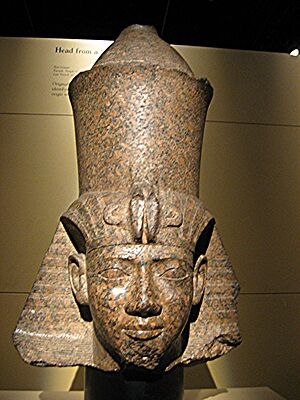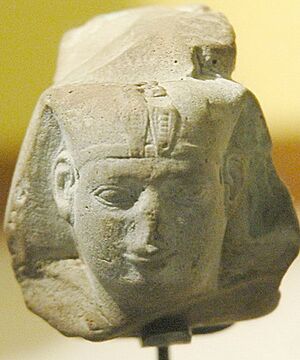Shabaka facts for kids
Quick facts for kids Shabaka |
|
|---|---|

Sphinx head of Shabaka, on display at the Egyptian Museum, Cairo
|
|
| Pharaoh | |
| Reign | 705–690 BC (25th Dynasty) |
| Predecessor | Shebitku |
| Successor | Taharqa |
| Consort | Qalhata, Mesbat, possibly Tabekenamun |
| Children | Tantamani, Haremakhet, Piankharty, Isetemkheb |
| Father | Kashta |
| Mother | Pebatjma |
| Died | 690 BC |
| Burial | el-Kurru |
| Monuments | Shabaka Stone |
Neferkare Shabaka, also known as Shabako, was an important pharaoh of ancient Egypt. He was the third ruler of the Twenty-fifth Dynasty of Egypt, which was a time when kings from the land of Kush (modern-day Sudan) ruled Egypt. Shabaka reigned from about 705 BC to 690 BC. He is mentioned in old Greek writings by historians like Herodotus.
Shabaka's Reign
Shabaka became pharaoh after his uncle, Shebitku. For a long time, historians debated if Shabaka ruled before or after Shebitku. But new discoveries from 2016 and 2017 show that Shebitku definitely ruled first. For example, writings on a quay (a kind of dock) at Karnak show Shabaka's inscriptions were carved over Shebitku's.
Another clue comes from the tombs of the Kushite kings. Shabaka's tomb is built in a similar way to Taharqa's tomb, which came later. Shebitku's tomb is more like Piye's, who ruled earlier. This also suggests Shabaka came after Shebitku.
Shabaka's rule was very important because he brought all of Egypt under the control of the Kushite kingdom. He also started many building projects across Egypt, especially in the city of Thebes. Thebes became the capital of his kingdom. In Karnak, he built a large pink granite statue of himself wearing the crowns of both Upper and Lower Egypt.
Shabaka worked hard to keep Egypt independent from other powerful empires, like the Neo-Assyrian Empire. One of the most famous items from his reign is the Shabaka Stone. This stone has copies of very old Egyptian documents that Shabaka wanted to save.
Archaeologists also found the Shabaka Gate in 2011. This was a large stone door that might have protected the room where the king's treasures were kept. Even though Shabaka and his family were from Kush, they were very interested in Egypt's long history and art.
Shabaka's Family
Shabaka was likely the son of King Kashta and Queen Pebatjma. His main wife was Qalhata, who was also the sister of the later pharaoh, Taharqa.
Shabaka and Qalhata had a son named Tantamani, who also became a pharaoh. It's also possible that Queen Tabekenamun was one of Shabaka's wives.
Another son of Shabaka was Haremakhet. He became a very important priest, known as the High Priest of Amun. We know about him from statues found in Karnak. A woman named Mesbat is mentioned on Haremakhet's sarcophagus, and she might have been his mother.
Shabaka had at least two more children whose mothers are not known. His daughter, Piankharty, later married her half-brother, Tantamani. Another daughter, Isetemkheb H, might have also married Tantamani.
Death and Burial
Shabaka is believed to have died in his 15th year as pharaoh, around 690 BC. He was buried in a pyramid at el-Kurru, a royal burial site in Kush. After Shabaka, his nephew Taharqa became the next pharaoh.
Images for kids








